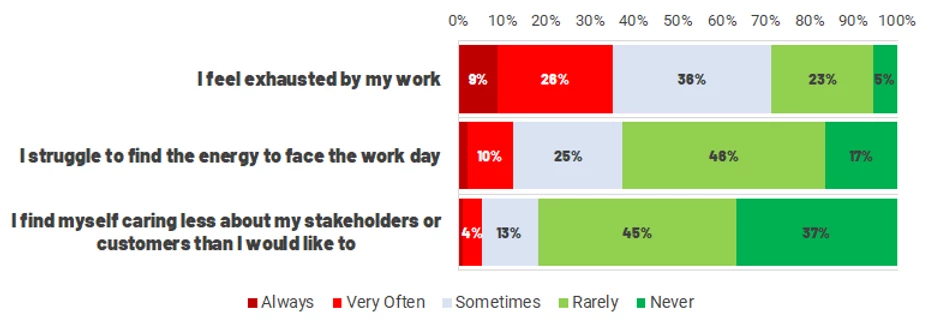What''s It Like To Experience Burnout at Work?
Burnout is a syndrome of emotional exhaustion and cynicism that often occurs among ‘people-workers’. How can you spot the signs of burnout at work and what should you be doing about it?
Well, The World Health Organisation (WHO) has recently classified burnout as an occupational phenomenon in the International Classification of Diseases.
What is burnout at work?
According to Maslach and Jackon
Burnout is a syndrome of emotional exhaustion and cynicism that occurs frequently among individuals who do ‘people-work’ of some kind. A key aspect of the burnout syndrome is increased feelings of emotional exhaustion. As their emotional resources are depleted, workers feel they are no longer able to give of themselves at a psychological level.
- Feelings of energy depletion or exhaustion
- Increased mental distance from one’s job
- Feelings of negativism or cynicism related to one’s job
- Reduced professional efficacy
What causes burnout at work?
There have been many studies looking at Burnout including The Maslach Burnout Inventory (MBI) which was developed by Christina Maslach and Susan Jackson to measure individual burnout.
The state of emotional exhaustion associated with burnout can be caused by a sustained imbalance between job demands and resources. Both job demands and resources can be physical, psychological, social and organisation, and examples of demands might include:
- Excessive workload
- Reduced autonomy (levels of control)
- The climate at work
- Poor reward/recognition for the job
- Being treated unfairly
- Values not being lived
If organisations are getting these wrong, then there could be a real risk to their people from burnout or other wellbeing issues.
What does our data show?
We measure burnout indicators as part of many of our surveys, and our research into workplace wellbeing has some potentially worrying results.
35% of all people we surveyed said that they were feeling exhausted by their work
1 in 5 (20%) of people said that they could not complete the work given to them in the time allowed.
30% of people said that they could not prioritise their own health and deliver on expected performance at work.
Managers may be at the most risk of burnout at work
The most significant impact was seen in the first line manager group where 35% said they could not complete the work in the time given and also could not prioritise their own health while maintaining expected performance at work.
This is obviously a worry: If we are asking people to make a choice between their own health and their performance at work, then we have the potential to cause conflict between priorities, and this may well drive down satisfaction and increase burnout risk.
Our other vital measures are shown in the chart below:

Taken from The People Experience Hub 2020 insights report
We can see that while 35% are exhausted a fewer people are lacking energy and fewer still are caring less about their customers.
This could suggest that burnout comes in incremental steps with exhaustion potentially being the first indicator. This is something that we''ll be keeping a keen eye on.
Cause or effect?
Looking at the data from our 2020 People Insights Report we can look at potential causes of burnout and see how we are performing against these. Our data shows us the following:
Excessive workload
20% cannot complete the work given to them in the time allowed
Reduced autonomy (levels of control)
48% of employees said they do not have freedom in the way they carry out their role
The climate at work
Climate is the second highest reason given for leaving a company
Poor reward/recognition for the job
51% of people said that they did not receive appropriate recognition when they did good work
Fairness and Values
48% said that their pay was not fair for the work they did, 56% said that they did not feel valued at work Data from The People Experience Hub 2020 insights report
How should this influence your wellbeing strategy?
It is interesting to see that Recognition, Fairness and Values are all potential causes of burnout at work. Our data suggests that we often are not delivering on these as well as we could do.
These are all low to zero cost items to deliver and simply require us to say thank you, treat people fairly and live our values – what is the barrier to doing this?
In general, the theory and research on burnout suggests that it is important to ensure that people are not consistently overloaded, aren''t burdened by hassles from ineffective processes, and are able to manage their work-life balancesufficiently to take time and recover from work. Additionally, social support structures and opportunities to develop help provide personal resources to counteract stressors.
Take Action
Understanding how your people feel and your risks of burnout, using our wellbeing surveys combined with your organisation''s data on absence, performance and other key indicators can help you see quickly if you are heading towards an issue with wellbeing.
